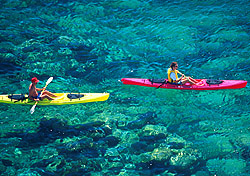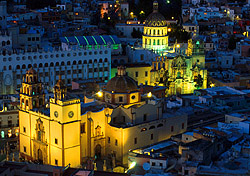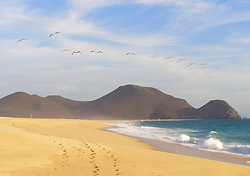 |
 |
 |
 Travel & Outdoors | February 2007 Travel & Outdoors | February 2007  
Ten Affordable, Under-the-Radar Mexican Cities and Beach Towns
 Molly Feltner - SmarterTravel.com Molly Feltner - SmarterTravel.com


| | The beach at Isla Mujeres, Quintana Roo. |

The U.S. might share a nearly 2,000-mile border with Mexico, a country almost three times the size of Texas, but most American travelers are familiar with only a handful of its destinations -Cancun, Puerto Vallarta, and other beach towns that cater to Americans.

While a relaxing vacation at a beach resort never hurt anyone, visitors who avoid traveling elsewhere are missing out on some of the best that Mexico has to offer: virgin beaches unspoiled by development, colonial cities that are older and more European than anything in the States, and indigenous cultures that still hold true to ancient traditions. All that, and lower prices, too.

In many colonial cities and small out-of-the-way beach towns, you'll find B&Bs and inns charging as little as $50 a night (or less) and luxurious accommodations in converted haciendas and Spanish estates for less than $150 a night. As for dining and shopping, you'll always find cheaper and more authentic food and handicrafts beyond the big tourist zones.

To experience Mexico outside the resorts you'll need to show a bit of independence and an openness to a less structured style of travel. Driving a rental car down crumbly roads, speaking some basic Spanish, and sharing your room with a lizard or two may be involved. Nevertheless, for the right kind of traveler, these elements are part of the excitement of venturing off the beaten path.

Here's a glimpse at 10 affordable, under-the-radar Mexican cities and beach towns that can be added on to a beach resort vacation or made the focus of a trip.

Loreto

 The jumping-off point for some of the best sea kayaking and whale watching in the world, Baja's Loreto draws adventure seekers who come to experience the Sea of Cortez' calm, cobalt-colored waters and proliferation of marine life. The Mexican government tried Cancun-style development in Loreto in the 1970s, but economic problems doomed the project to failure. Today, the town of Loreto still retains much of its local character, and National Marine Park status protects the sea and islands surrounding Loreto. However, a new development is in the works just a few miles down the coast, so hurry and visit before the resorts - and prices - go up. The jumping-off point for some of the best sea kayaking and whale watching in the world, Baja's Loreto draws adventure seekers who come to experience the Sea of Cortez' calm, cobalt-colored waters and proliferation of marine life. The Mexican government tried Cancun-style development in Loreto in the 1970s, but economic problems doomed the project to failure. Today, the town of Loreto still retains much of its local character, and National Marine Park status protects the sea and islands surrounding Loreto. However, a new development is in the works just a few miles down the coast, so hurry and visit before the resorts - and prices - go up.

Protected from the rough waters of the Pacific, the Sea of Cortez and its desert islands are an ideal breeding ground for whales, dolphins, sea lions, and other marine animals-and great for kayakers too. One of the top operators in the area, Sea Kayak Adventures, Inc, offers several Sea of Cortez trips ranging from six to 12 days and starting at $930 per person.

"[The water] is mostly glassy calm; we paddle around sea cliffs, headlands, and by sea caves, and then camp in sheltered coves with brilliant white-sand beaches," says Nancy Mertz, co-founder of the company. "There are blue, fin, and occasionally humpback whales in the Sea of Cortez that can be viewed as well as scores of common dolphins, California sea lions, various rays (some leap out of the water), sea turtles, and lots of fish."

Trips include airport transfers, accommodations, kayaking equipment, meals, and guides. Time is usually available each day for snorkeling, island exploring, and wildlife watching. One- and three-day gray whale-watching trips to the Pacific coast can be added to most itineraries.

Loreto itself is worth seeing, too, especially while it's still a small, mostly Mexican town. "The people are what I liked most about Loreto," says SmarterTravel.com's Marketing Director Ray Hibbard, who visited Loreto on a friend's recommendation. "The locals are very friendly and, because it's not a major resort town, you have lots more opportunity for authentic interaction with them. [For example], when I was walking back from an area five miles outside of town, a local picked me up in his truck and gave me a lift. I offered a tip, but he wouldn't accept it."

Getting there: Sample fares from Los Angeles to Loreto in the winter and spring (whale-watching season) start around $200 plus taxes on Delta.

Where to stay: The recently built Coco Cabañas has eight cabañas with kitchens, dining areas, and covered porches for $70 per night.

Online resources: Learn more by browsing Loreto.com, GoToLoreto.com, and the Loreto travel guide on Mexperience.com.

Guanajuato

 "Mexico meets Europe in Guanajuato," says Clara Moore, manager of the local La Casa de Espíritus Alegres B&B. Located in central Mexico's silver-rich mountains, Guanajuato grew from an Indian settlement to the second wealthiest and most important city in New Spain by the end of the 18th century. It's still one of Mexico's most splendid cities-it was designated a UNESCO World Heritage Site in 1988-and thanks to its unique design, it has avoided the massive sprawl and confusion of its big brother, Mexico City. "Mexico meets Europe in Guanajuato," says Clara Moore, manager of the local La Casa de Espíritus Alegres B&B. Located in central Mexico's silver-rich mountains, Guanajuato grew from an Indian settlement to the second wealthiest and most important city in New Spain by the end of the 18th century. It's still one of Mexico's most splendid cities-it was designated a UNESCO World Heritage Site in 1988-and thanks to its unique design, it has avoided the massive sprawl and confusion of its big brother, Mexico City.

"Guanajuato was built in a ravine, on the site of an old riverbed," says Moore. "This caused the city to have been built in a very naturalistic way. The streets wind and dip as the water would have flowed, houses cling to the hillside for dear life, and every bit of land is used economically. Underneath the city, traffic flows through tunnels where the river ran."

The University of Guanajuato has also helped shape the town's prevailing intellectual atmosphere, creating a place where the arts, high-quality museums, and bohemian-style cafes and coffeehouses flourish. Two cultural institutions worth visiting are the Museo Casa Diego Rivera, dedicated to the paintings of Guanajuato-born Rivera, and the Museo Iconográfico del Quijote, which houses a collection of artifacts associated with Cervantes' Don Quixote. Guanajuato's love for Cervantes and Spanish literature manifests itself every October at the International Cervantes Festival, which attracts artists and performers from around the world. Guanajuato is also where Mexico's War of Independence had its bloody beginnings. You can climb to the top of a hill above the city and see a monument to the war hero El Pipila as well as a panoramic view of the city.

However, perhaps wandering the city's narrow streets and tree-lined plazas or sitting in an outdoor cafe watching groups of student troubadours and mariachis perform is the best way to spend time in the city. "The city is urban, but it hasn't lost its small town feel," says Moore. "Walking in the streets or gardens, you can expect to be greeted with smiles and helpful words."

Getting there: Sample summer fares from Houston to Guanajuato's airport start around $300 plus taxes on American. Taxis into town cost about $30.

Where to stay: Started by two artists in a 17th-century hacienda just outside the city, La Casa de Espíritus Alegres B&B is famous for its displays of folk art and tapestries from Mexico and India. "Every nook and cranny is filled with brightly colored, beautiful things and each room has a theme, including Quetzal (a southern bird), Nagual (the bed is lined with dream masks), and Raj Mahal (full of treasures from the owners' trips to India)," says Moore. Rates start at $145 per night and include breakfast.

For cheaper accommodations near the city center, try the six-room Villa Sandí B&B, which has rates from $50 per night.

Online resources: Learn more by browsing GuanajuatoCapital.com or the Guanajuato guides on Mexperience.com and MEXonline.com.

Pátzcuaro

 Among experienced Mexico travelers, one of the destinations that emerges repeatedly as a favorite is Pátzcuaro, a small colonial city about 200 miles west of Mexico City. Situated on the thickly forested shores of Lake Pátzcuaro at about 7,200 feet, the town's lush surroundings surprise many visitors, as does its abundance of authentic culture and dearth of tourists. Among experienced Mexico travelers, one of the destinations that emerges repeatedly as a favorite is Pátzcuaro, a small colonial city about 200 miles west of Mexico City. Situated on the thickly forested shores of Lake Pátzcuaro at about 7,200 feet, the town's lush surroundings surprise many visitors, as does its abundance of authentic culture and dearth of tourists.

"Pátzcuaro stands out because it appears to be caught in a time warp, with its white adobe buildings and red-tiled roofs, converted monasteries, and visible indigenous population in authentic dress," says North Carolinian Trish Snyder, who particularly appreciated the town's lack of Dunkin' Donuts and other signs of commercialization.

The native Purepecha Indians have a strong presence in the city, hosting many elaborate religious festivals throughout the year and producing some of the finest handicrafts in the country. This is thanks in part to traditions put in place more than 450 years ago by the city's founder, Bishop Vasco de Quiroga. Arriving in the region shortly after conquistadors ravaged the local Indians, the Bishop sought to evangelize and empower the indigenous communities by organizing religious instruction and communal craft industries in each village. The positive effects of this continue today, with the ancestors of those Indians continuing the same craft work. Throughout the area, you can shop for regionally produced items such as embroidered textiles, silver jewelry, pottery, and musical instruments. Try the La Casa de los Once Patios shops on Calle Madrigal de las Torres.

While in town, it's worthwhile to venture out on to the lake. "Taking a small boat across Lake Pátzcuaro to Isla de Janitzio is a must," says Ottawa-based writer Julie Hawrishok. "If you're lucky, you will see the butterfly fishermen honing their skills. On Janitzio, climbing the hill (there are no roads on the island) and getting to the 40-meter-high statue of José Maria Morelos can literally take your breath away."

Getting there: Pátzcuaro is about 43 miles from Morelia, where the nearest major airport is located. Sample fares on Continental from Houston start at about $400 plus taxes this summer. There is frequent, cheap first-class bus service from Morelia to Pátzcuaro.

Where to stay: Hawrishok highly recommends staying at the former 17th-century mansion Hotel Mansion Iturbe, whose rates start at $90 per night, including breakfast. "It's a great colonial hotel, located right in front of Quiroga, the main square," say Hawrishok. "It's not cheap, but it's worth it."

Online resources: Visit PatzcuaroMexico.com or the Pátzcuaro resource pages on the Mexico Tourism Board website, Mexperience.com, and MEXonline.com to learn more.

Todos Santos

 Todos Santos, an hour north of Cabo San Lucas on the Baja Peninsula, is an art enclave where artists go to escape from other, too-chic art enclaves. It's cheaper, quieter, smaller, more laid-back, and more remote than places like Taos, Santa Fe, or Soho. And its sunny weather, tropical surroundings, and colorful Mexican traditions are perfect inspirations for painters and other artists. Oh, and its nearby beaches are beautiful and practically empty. Bad rip tides make them rough for swimmers-and unappealing to big resort developers. They, along with the celebrities and package tourists, go to Cabo instead. Todos Santos, an hour north of Cabo San Lucas on the Baja Peninsula, is an art enclave where artists go to escape from other, too-chic art enclaves. It's cheaper, quieter, smaller, more laid-back, and more remote than places like Taos, Santa Fe, or Soho. And its sunny weather, tropical surroundings, and colorful Mexican traditions are perfect inspirations for painters and other artists. Oh, and its nearby beaches are beautiful and practically empty. Bad rip tides make them rough for swimmers-and unappealing to big resort developers. They, along with the celebrities and package tourists, go to Cabo instead.

Nevertheless, times may be changing for Todos, so it's worth visiting soon. "Although changes are evident over the last couple of years, Todos Santos is still a quiet, laid-back fishing and agricultural town without the tourist traps or pushy vendors one finds in Cabo," says John Stoltzfus, proprietor of the Todos Santos Inn.

The town is small, just a few square blocks, and best taken as a place to relax or as a base for surfing or exploring Baja's interior. In town, Stoltzfus recommends visiting the Galeria de Todos Santos, Jill Logan Gallery, and Charles Stewart Gallery-three of the most prominent Todos Santos galleries. Attending yoga classes, meditation sessions, and evening music performances are options as well. Foodies won't be disappointed either by Todos' diverse, albeit somewhat pricey options. Try Café Santa Fe, which has earned praise from the New York Times and Travel + Leisure. There are always fish tacos available at take-out locations for those on a budget.

Out of town, surfers can head to Playa San Pedrito, Playa Los Cerritos, or La Pastora, all a few miles' drive away. Los Cerritos is also one of the few beaches with some safe swimming areas. If you're not a surfer, you can try adventure activities like hikes along coastal cliffs or inland canyons, fishing, or horseback riding.

Getting there: To get to Todos, fly to the Cabo San Lucas airport and then rent a car or take a taxi (about $100). Sample fares from Los Angeles in the spring start around $200, excluding taxes, on a variety of major U.S. carriers.

Where to stay: The Todos Santos Inn, a 19th-century hacienda in the center of town, offers luxurious accommodations at a reasonable price. Rates start at $125 per night and include continental breakfast. The hotel and its rooms are decorated with period antiques, and its on-site wine bar is stocked with a wide range of international vintages.

If you want something a bit more affordable, the friendly Casa Bentley has six suites and starts at $80 per night.

Online resources: Learn more by visiting TodosSantos.cc, TodosSantos-Baja.com, and TodosSantos.com. | 
 | |
 |



